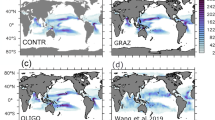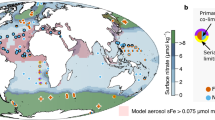Abstract
THE supply of dissolved inorganic carbon (DIC) is not considered to limit oceanic primary productivity1, as its concentration in sea water exceeds that of other plant macronutrients such as nitrate and phosphate by two and three orders of magnitude, respectively. But the bulk of oceanic new production2 and a major fraction of vertical carbon flux is mediated by a few diatom genera whose ability to use DIG components other than CO2, which comprises < 1% of total DIC3, is unknown4. Here we show that under optimal light and nutrient conditions, diatom growth rate can in fact be limited by the supply of CO2. The doubling in surface water pCO2 levels since the last glaciation from 180 to 355 p.p.m.5,6 could therefore have stimulated marine productivity, thereby increasing oceanic carbon sequestration by the biological pump.
This is a preview of subscription content, access via your institution
Access options
Subscribe to this journal
Receive 51 print issues and online access
$199.00 per year
only $3.90 per issue
Buy this article
- Purchase on Springer Link
- Instant access to full article PDF
Prices may be subject to local taxes which are calculated during checkout
Similar content being viewed by others
References
Strickland, J. D. H. in Chemical Oceanography (eds Riley, J. P. & Skirrow, G.) 1, 477 (Academic, London, 1965).
Eppley, R. W. & Petersen, B. J. Nature 282, 677–680 (1979).
Stumm, W. & Morgan, J. J. Aquatic Chemistry (Wiley-Interscience, New York 1981).
Raven, J. A. Plant Cell Environm. 14, 779–794 (1991).
Berner, W., Oeschger, H. & Stauffer, B. Radiocarbon 22, 227–235 (1980).
Neftel, A., Oeschger, H., Schwander, J., Stauffer, B. & Zumbrunn, R. Nature 295, 220–223 (1982).
Rau, G. H., Takahashi, T. & Des Marais, D. J. Nature 341, 516–518 (1989).
Deuser, W. G. Nature 205, 1069–1071 (1970).
Degens, E. T., Guillard, R. R. L., Sackett, W. M. & Hellebust, J. A. Deep Sea Res. 15, 1–9 (1968).
Lazier, J. R. N. & Mann, K. H. Deep Sea Res. 36, 1721–1733 (1989).
Gavis, J. & Ferguson, J. F. Limnol. Oceanogr. 20, 211–221 (1975).
Raymont, E. G. Plankton and Productivity in the Oceans (Pergamon, Oxford, 1980).
Lax, E. & Synowietz, C. Taschenbuch für Chemiker und Physiker (Springer, Berlin, 1967).
Li, Y. H. & Gregory, S. Geochim. cosmochim. Acta 38, 703–714 (1974).
Redfield, A. C. Amer. Sci. 46, 205–221 (1958).
Monod, J. Recherche sur la Croissance des Cultures Bactériennes (Hermann, Paris, 1942).
Eppley, R. W. Fish Bull. 70, 1063–1085 (1972).
Raven, J. A. & Johnston, A. M. Limnol. Oceanogr. 36, 1701–1714 (1991).
Eppley, R. W., Rogers, J. N. & McCarthy, J. J. Limnol. Oceanogr. 14, 912–920 (1969).
Codispoti, L. A., Friederich, G. E., Iverson, R. L. & Hood, D. W. Nature 296, 242–245 (1982).
Riebesell, U. & Wolf-Gladrow, D. A. Deep Sea Res. 39, 1085–1102 (1992).
Broecker, W. S. Glob. Biogeochem. Cycles 5, 191–192 (1991).
Smith, S. V. & Mackenzie, F. T. Glob. Biogeochem. Cycles 5, 189–190 (1991).
v.Stosch, H. A. & Drebes, G. Helgol. Wiss. Meeres. 11, 209–257 (1964).
Grasshoff, K., Ehrhardt, M. & Kremling, K. Methods of Seawater Analysis (Basel Verlag, Chemie, Basel, 1983).
Author information
Authors and Affiliations
Rights and permissions
About this article
Cite this article
Riebesell, U., Wolf-Gladrow, D. & Smetacek, V. Carbon dioxide limitation of marine phytoplankton growth rates. Nature 361, 249–251 (1993). https://doi.org/10.1038/361249a0
Received:
Accepted:
Published:
Issue Date:
DOI: https://doi.org/10.1038/361249a0
This article is cited by
-
Acidification of seawater attenuates the allelopathic effects of Ulva pertusa on Karenia mikimotoi
Environmental Science and Pollution Research (2023)
-
Enhancement of diatom growth and phytoplankton productivity with reduced O2 availability is moderated by rising CO2
Communications Biology (2022)
-
Simulated ocean acidification altered community composition and growth of a coastal phytoplankton assemblage (South West coast of India, eastern Arabian Sea)
Environmental Science and Pollution Research (2022)
-
Proteomic and biochemical responses to different concentrations of CO2 suggest the existence of multiple carbon metabolism strategies in Phaeodactylum tricornutum
Biotechnology for Biofuels (2021)
-
Environmental stability impacts the differential sensitivity of marine microbiomes to increases in temperature and acidity
The ISME Journal (2021)
Comments
By submitting a comment you agree to abide by our Terms and Community Guidelines. If you find something abusive or that does not comply with our terms or guidelines please flag it as inappropriate.



